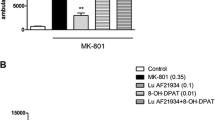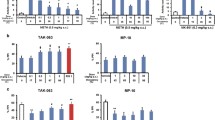Abstract
The partial agonist profile of novel antipsychotics such as aripiprazole has hardly been demonstrated in biochemical assays on animal tissues. As it is established that responses induced by dopamine D2 receptor agonists are increased in models of dopaminergic sensitization, this paradigm was used in order to facilitate the detection of the partial agonist properties of aripiprazole. At variance with all other partial and full agonists tested, the partial agonist properties of aripiprazole were not revealed in guanosine 5′-O-(γ-[35S]thiotriphosphate ([35S]GTPγS) binding assays on striatal membranes from haloperidol-treated rats. Hence, aripiprazole behaved as an antagonist, efficiently inhibiting the functional response to dopamine. Similarly, in behavioural assays, aripiprazole dose-dependently inhibited the stereotypies elicited by apomorphine. However, at variance with haloperidol, repeated administrations of aripiprazole (3 weeks) at the doses of 10 and 30 mg/kg did not induce any up-regulation or hyperfunctionality of the dopamine D2 receptors in the striatum. These data highlight the putative involvement of other pharmacological targets for aripiprazole that would support in the prevention of secondary effects commonly associated with the blockade of striatal dopamine D2 receptors. Hence, in additional experiments, aripiprazole was found to efficiently promote [35S]GTPγS binding in hippocampal membranes through the activation of 5-HT1A receptors. Further experiments investigating the second-messenger cascades should be performed so as to establish the functional properties of aripiprazole and understand the mechanism underlying the prevention of dopamine receptor regulation in spite of the observed antagonism.







Similar content being viewed by others
References
Allikmets LH, Zarkovsky AM, Nurk AM (1981) Changes in catalepsy and receptor sensitivity following chronic neuroleptic treatment. Eur J Pharmacol 75:145–147
Assie MB, Mnie-Filali O, Ravailhe V, Benas C, Marien M, Betry C, Zimmer L, Haddjeri N, Newman-Tancredi A (2009) F15063, a potential antipsychotic with dopamine D2/D3 receptor antagonist, 5-HT1A receptor agonist and dopamine D4 receptor partial agonist properties: influence on neuronal firing and neurotransmitter release. Eur J Pharmacol 607:74–83
Bardin L, Kleven MS, Barret-Grevoz C, Depoortere R, Newman-Tancredi A (2006) Antipsychotic-like vs cataleptogenic actions in mice of novel antipsychotics having D2 antagonist and 5-HT1A agonist properties. Neuropsychopharmacology 31:1869–1879
Bernardi MM, De Souza H, Palermo NJ (1981) Effects of single and long-term haloperidol administration on open field behavior of rats. Psychopharmacol Berl 73:171–175
Bradford MM (1976) A rapid and sensitive method for the quantitation of microgram quantities of protein utilizing the principle of protein-dye binding. Anal Biochem 72:248–254
Burris KD, Molski TF, Xu C, Ryan E, Tottori K, Kikuchi T, Yocca FD, Molinoff PB (2002) Aripiprazole, a novel antipsychotic, is a high-affinity partial agonist at human dopamine D2 receptors. J Pharmacol Exp Ther 302:381–389
Centonze D, Grande C, Usiello A, Gubellini P, Erbs E, Martin AB, Pisani A, Tognazzi N, Bernardi G, Moratalla R, Borrelli E, Calabresi P (2003) Receptor subtypes involved in the presynaptic and postsynaptic actions of dopamine on striatal interneurons. J Neurosci 23:6245–6254
Cooper SJ, Rusk IN, Barber DJ (1989) Yawning induced by the selective dopamine D2 agonist N-0437 is blocked by the selective dopamine autoreceptor antagonist (+)-UH 232. Physiol Behav 45:1263–1266
Cordeaux Y, Nickolls SA, Flood LA, Graber SG, Strange PG (2001) Agonist regulation of D(2) dopamine receptor/G protein interaction. Evidence for agonist selection of G protein subtype. J Biol Chem 276:28667–28675
Cosi C, Carilla-Durand E, Assie MB, Ormiere AM, Maraval M, Leduc N, Newman-Tancredi A (2006) Partial agonist properties of the antipsychotics SSR181507, aripiprazole and bifeprunox at dopamine D2 receptors: G protein activation and prolactin release. Eur J Pharmacol 535:135–144
Fujikawa M, Nagashima M, Inoue T, Yamada K, Furukawa T (1996) Partial agonistic effects of OPC-14597, a potential antipsychotic agent, on yawning behavior in rats. Pharmacol Biochem Behav 53:903–909
Geurts M, Hermans E, Maloteaux JM (1999a) Assessment of striatal D1 and D2 dopamine receptor-G protein coupling by agonist-induced [35S]GTP gamma S binding. Life Sci 65:1633–1645
Geurts M, Hermans E, Maloteaux JM (1999b) Enhanced striatal dopamine D(2) receptor-induced [35S]GTPgammaS binding after haloperidol treatment. Eur J Pharmacol 382:119–127
Han M, Huang XF, Deng C (2009) Aripiprazole differentially affects mesolimbic and nigrostriatal dopaminergic transmission: implications for long-term drug efficacy and low extrapyramidal side-effects. Int J Neuropsychopharmacol 10:1–12
Hermans E (2003) Biochemical and pharmacological control of the multiplicity of coupling at G-protein-coupled receptors. Pharmacol Ther 99:25–44
Hermans E, Challiss RA, Nahorski SR (1999) Effects of varying the expression level of recombinant human mGlu1alpha receptors on the pharmacological properties of agonists and antagonists. Br J Pharmacol 126:873–882
Hoyer D, Boddeke HW (1993) Partial agonists, full agonists, antagonists: dilemmas of definition. Trends Pharmacol Sci 14:270–275
Inoue T, Domae M, Yamada K, Furukawa T (1996) Effects of the novel antipsychotic agent 7-(4-[4-(2,3-dichlorophenyl)-1-piperazinyl]butyloxy)-3,4-dihydro-2(1H)-quinolinone (OPC-14597) on prolactin release from the rat anterior pituitary gland. J Pharmacol Exp Ther 277:137–143
Inoue A, Miki S, Seto M, Kikuchi T, Morita S, Ueda H, Misu Y, Nakata Y (1997) Aripiprazole, a novel antipsychotic drug, inhibits quinpirole-evoked GTPase activity but does not up-regulate dopamine D2 receptor following repeated treatment in the rat striatum. Eur J Pharmacol 321:105–111
Ishikane T, Kusumi I, Matsubara R, Matsubara S, Koyama T (1997) Effects of serotonergic agents on the up-regulation of dopamine D2 receptors induced by haloperidol in rat striatum. Eur J Pharmacol 321:163–169
Jong-Yih L (2009) Successful switch from clozapine to aripiprazole: a case report. J Clin Psychopharmacol 29:93–95
Jordan S, Koprivica V, Chen R, Tottori K, Kikuchi T, Altar CA (2002) The antipsychotic aripiprazole is a potent, partial agonist at the human 5-HT1A receptor. Eur J Pharmacol 441:137–140
Jordan S, Johnson JL, Regardie K, Chen R, Koprivica V, Tadori Y, Kambayashi J, Kitagawa H, Kikuchi T (2007a) Dopamine D2 receptor partial agonists display differential or contrasting characteristics in membrane and cell-based assays of dopamine D2 receptor signaling. Prog Neuropsychopharmacol Biol Psychiatry 31:348–356
Jordan S, Regardie K, Johnson JL, Chen R, Kambayashi J, McQuade R, Kitagawa H, Tadori Y, Kikuchi T (2007b) In vitro functional characteristics of dopamine D2 receptor partial agonists in second and third messenger-based assays of cloned human dopamine D2Long receptor signalling. J Psychopharmacol 21:620–627
Kane JM, Carson WH, Saha AR, McQuade RD, Ingenito GG, Zimbroff DL, Ali MW (2002) Efficacy and safety of aripiprazole and haloperidol versus placebo in patients with schizophrenia and schizoaffective disorder. J Clin Psychiatry 63:763–771
Khan ZU, Mrzljak L, Gutierrez A, de la Calle A, Goldman-Rakic PS (1998) Prominence of the dopamine D2 short isoform in dopaminergic pathways. Proc Natl Acad Sci USA 95:7731–7736
Kikuchi T, Tottori K, Uwahodo Y, Hirose T, Miwa T, Oshiro Y, Morita S (1995) 7-(4-[4-(2,3-Dichlorophenyl)-1-piperazinyl]butyloxy)-3,4-dihydro-2(1H)-quinolinone (OPC-14597), a new putative antipsychotic drug with both presynaptic dopamine autoreceptor agonistic activity and postsynaptic D2 receptor antagonistic activity. J Pharmacol Exp Ther 274:329–336
Kiss B, Horvath A, Nemethy Z, Schmidt E, Laszlovszky I, Bugovics G, Fazekas K, Hornok K, Orosz S, Gyertyan I, Agai-Csongor E, Domany G, Tihanyi K, Adham N, Szombathelyi Z (2010) Cariprazine (RGH-188), a dopamine D(3) receptor-preferring, D(3)/D(2) dopamine receptor antagonist–partial agonist antipsychotic candidate: in vitro and neurochemical profile. J Pharmacol Exp Ther 333:328–340
Kleven MS, Barret-Grevoz C, Bruins SL, Newman-Tancredi A (2005) Novel antipsychotic agents with 5-HT(1A) agonist properties: role of 5-HT(1A) receptor activation in attenuation of catalepsy induction in rats. Neuropharmacology 49:135–143
Koener B, Hermans E, Maloteaux JM, Jean-Jean A, Constant EL (2007) Paradoxical motor syndrome following a switch from atypical neuroleptics to aripiprazole. Am J Psychiatry 164:1437–1438
Kohnomi S, Suemaru K, Kawasaki H, Araki H (2008) Effect of aripiprazole on 5-HT2 receptor-mediated wet-dog shake responses and disruption of prepulse inhibition in rats. J Pharmacol Sci 106:645–650
Lin H, Saisch SG, Strange PG (2006) Assays for enhanced activity of low efficacy partial agonists at the D(2) dopamine receptor. Br J Pharmacol 149:291–299
Lindgren N, Usiello A, Goiny M, Haycock J, Erbs E, Greengard P, Hokfelt T, Borrelli E, Fisone G (2003) Distinct roles of dopamine D2L and D2S receptor isoforms in the regulation of protein phosphorylation at presynaptic and postsynaptic sites. Proc Natl Acad Sci USA 100:4305–4309
Meller E, Helmer-Matyjek E, Bohmaker K, Adler CH, Friedhoff AJ, Goldstein M (1986) Receptor reserve at striatal dopamine autoreceptors: implications for selectivity of dopamine agonists. Eur J Pharmacol 123:311–314
Minematsu N (1995) Behavioral effects of chronic apomorphine, and D-1/D-2 dopamine receptor activities in rats. Nihon Shinkei Seishin Yakurigaku Zasshi 15:247–252
Nakai S, Hirose T, Uwahodo Y, Imaoka T, Okazaki H, Miwa T, Nakai M, Yamada S, Dunn B, Burris KD, Molinoff PB, Tottori K, Altar CA, Kikuchi T (2003) Diminished catalepsy and dopamine metabolism distinguish aripiprazole from haloperidol or risperidone. Eur J Pharmacol 472:89–97
Neal-Beliveau BS, Joyce JN, Lucki I (1993) Serotonergic involvement in haloperidol-induced catalepsy. J Pharmacol Exp Ther 265:207–217
Nickolls SA, Strange PG (2004) The influence of G protein subtype on agonist action at D2 dopamine receptors. Neuropharmacology 47:860–872
Odagaki Y, Toyoshima R (2005) 5-HT1A receptor-mediated G protein activation assessed by [35S]GTPgammaS binding in rat cerebral cortex. Eur J Pharmacol 521:49–58
Odagaki Y, Toyoshima R (2007) 5-HT1A receptor agonist properties of antipsychotics determined by [35S]GTPgammaS binding in rat hippocampal membranes. Clin Exp Pharmacol Physiol 34:462–466
Olianas MC, Onali P (1987) Supersensitivity of striatal D2 dopamine receptors mediating inhibition of adenylate cyclase and stimulation of guanosine triphosphatase following chronic administration of haloperidol in mice. Neurosci Lett 78:349–354
Prinssen EP, Kleven MS, Koek W (1999) Interactions between neuroleptics and 5-HT(1A) ligands in preclinical behavioral models for antipsychotic and extrapyramidal effects. Psychopharmacol Berl 144:20–29
Semba J, Watanabe A, Kito S, Toru M (1995) Behavioural and neurochemical effects of OPC-14597, a novel antipsychotic drug, on dopaminergic mechanisms in rat brain. Neuropharmacology 34:785–791
Shapiro DA, Renock S, Arrington E, Chiodo LA, Liu LX, Sibley DR, Roth BL, Mailman R (2003) Aripiprazole, a novel atypical antipsychotic drug with a unique and robust pharmacology. Neuropsychopharmacology 28:1400–1411
Tadori Y, Miwa T, Tottori K, Burris KD, Stark A, Mori T, Kikuchi T (2005) Aripiprazole’s low intrinsic activities at human dopamine D2L and D2S receptors render it a unique antipsychotic. Eur J Pharmacol 515:10–19
Tadori Y, Forbes RA, McQuade RD, Kikuchi T (2009) Receptor reserve-dependent properties of antipsychotics at human dopamine D2 receptors. Eur J Pharmacol 607:35–40
Tamminga CA, Carlsson A (2002) Partial dopamine agonists and dopaminergic stabilizers, in the treatment of psychosis. Curr Drug Targets CNS Neurol Disord 1:141–147
Urban JD, Vargas GA, von Zastrow M, Mailman RB (2007) Aripiprazole has functionally selective actions at dopamine D2 receptor-mediated signaling pathways. Neuropsychopharmacology 32:67–77
Wang LJ, Ree SC, Chen CK (2009) Courses of aripiprazole-associated tardive dyskinesia: report of two cases. Prog Neuropsychopharmacol Biol Psychiatry 33:743–744
Watts VJ, Lawler CP, Gonzales AJ, Zhou QY, Civelli O, Nichols DE, Mailman RB (1995) Spare receptors and intrinsic activity: studies with D1 dopamine receptor agonists. Synapse 21:177–187
Wood MD, Scott C, Clarke K, Westaway J, Davies CH, Reavill C, Hill M, Rourke C, Newson M, Jones DN, Forbes IT, Gribble A (2006) Aripiprazole and its human metabolite are partial agonists at the human dopamine D2 receptor, but the rodent metabolite displays antagonist properties. Eur J Pharmacol 546:88–94
Acknowledgements
We thank T. Timmerman and R. Lenaert for their excellent technical assistance. This work was supported by the National Fund for Scientific Research (F.N.R.S., Belgium, Convention FRSM 3.4.513.10F and Crédit au Chercheur 1.5.109.09F). BK and EH are Research fellow and Research Director of the F.N.R.S., respectively.
Author information
Authors and Affiliations
Corresponding author
Rights and permissions
About this article
Cite this article
Koener, B., Goursaud, S., Van De Stadt, M. et al. Pharmacological blockade of dopamine D2 receptors by aripiprazole is not associated with striatal sensitization. Naunyn-Schmied Arch Pharmacol 383, 65–77 (2011). https://doi.org/10.1007/s00210-010-0577-7
Received:
Accepted:
Published:
Issue Date:
DOI: https://doi.org/10.1007/s00210-010-0577-7




